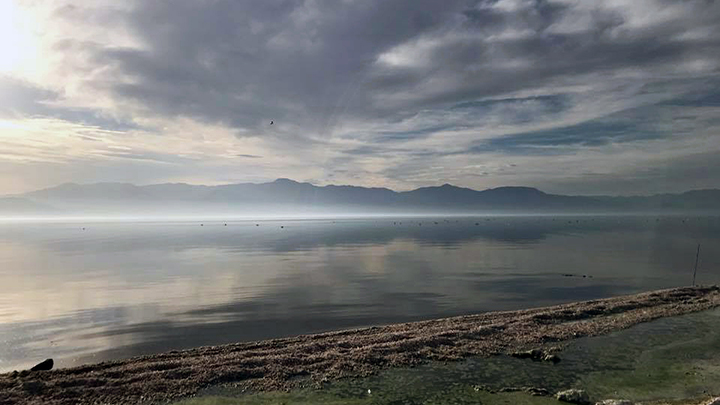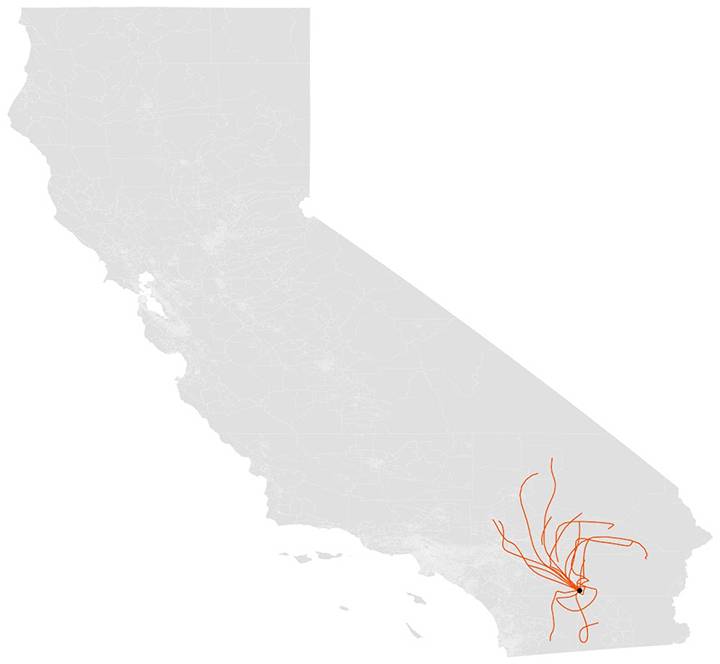Dust from the drying Salton Sea pollutes nearby communities
Joint study finds increased particulate air pollution following 2011 diversion of water to San Diego.

When desert winds stir up dust from the Salton Sea’s exposed lakebed, nearby communities suffer from increased air pollution. The deterioration coincides with reduced flows into California’s largest lake, according to a new study in the American Journal of Agricultural Economics by San Diego State University, University of California, Davis and Arizona State University researchers.
“What we find is that historically disadvantaged communities are receiving the brunt of this air pollution,” said co-author Ryan Abman, associate professor of economics at SDSU.
The Salton Sea has been shrinking for years, according to co-author Eric Edwards, assistant professor of agricultural economics at University of California, Davis, who worked on the study while at North Carolina State University. The dust created by the drying of the lakebed increases pollution that reaches surrounding communities.
“We have a dusty area, and any time there is wind, it’s going to pick up dust and move it around,” Edwards said.
The Salton Sea formed in 1905 after the Colorado River overflowed its banks and the floodwaters settled into what was known as the Salton Sink. It was primarily fed by water runoff from agricultural operations for almost a century. As Southern California struggled to meet growing water demand, the Imperial Irrigation District agreed to send water to San Diego for urban use.
Imperial, which supplies water to vast desert farms as well as seven towns and two special districts, is the largest user of Colorado River water. The agreement with San Diego required agricultural water users to increase efficiency and reduce their water consumption, which reduced water running into the Salton Sea, Edwards said.
“Farmers started capturing the water that would run off and otherwise recharge the lake with the unanticipated consequence of starting to reduce the water level, which has important environmental implications,” said Abman.
The reductions increased the lake’s already high salt content, which also harmed wildlife habitats and created localized air pollution. The area is the subject of many environmental restoration projects.
Tracking pollution
The researchers used a particle transport model to study the effects of changing water diversions on particulate pollution.
They found the paths of fine particulate matter — which can cause asthma, heart and respiratory issues when inhaled — were associated with higher air pollution readings after Imperial began reducing runoff water to the Salton Sea around 2011 in order to transfer it to San Diego, a practice that continues today.
The researchers modeled lakebed exposure by dividing the lake’s shoreline into one square kilometer grids and analyzed daily air pollution data from 1998 to 2018. They added data about the exposed lakebed, or playa, and used a physics model called HYSPLIT to factor in wind levels and particle size to track the movement of dust over time. State health screening information available by ZIP Code added more to the story by pinpointing disadvantaged areas, asthma rates and other vulnerabilities.
Lake levels were higher in 1998 before the transfers, so the change was not evident until the lakebed became more exposed.
“Post-2011, there is an increase in particles going through disadvantaged communities relative to non-disadvantaged communities, which are farther away from the sea,” Edwards said.
In the paper, pollution paths are depicted on a map of the state. The Salton Sea is marked with a black dot, and red lines radiate from there to distances of 100 miles or more.
 Open the image full screen.
Open the image full screen.“From every exposed grid cell you have these paths predicting where the particles are going based on physics,” Edwards said. “That’s the path of emissions.”
Prior research suggests dust particles from newly exposed playa are more susceptible to wind erosion.
“There’s lots of evidence that playa is particularly emissive in terms of dust,” Edwards said. “If it’s dry, those particles get picked up readily by the wind and create dust — and at rates higher than areas that have been exposed to the wind over long periods of time.”
Dust pollution from exposed dry lake beds has become “a really common problem,” Abman said, and has also been seen in the Great Salt Lake.
Informed policy
Edwards said policymakers and regulators should consider the health and environmental impacts of water diversions in their decision-making.
“The drying up of the Salton Sea has serious health consequences that have generally fallen on more disadvantaged populations, who may not be well equipped to advocate for policies that improve their health,” he said.
“What we hope comes out of this research is that we pay more attention to the air pollution effects that these agricultural policy decisions have,” added Abman.
Dana Hernandez-Cortes from Arizona State University also collaborated on the research. Funding was provided by The U.S. Department of Agriculture’s National Institute of Food and Agriculture. UC Davis contributed to the content of this story.


